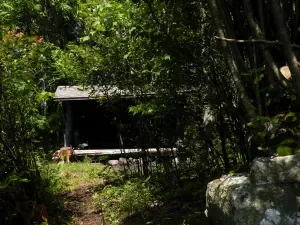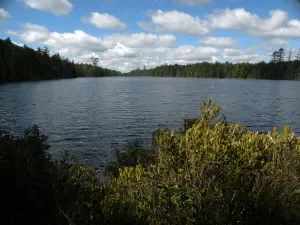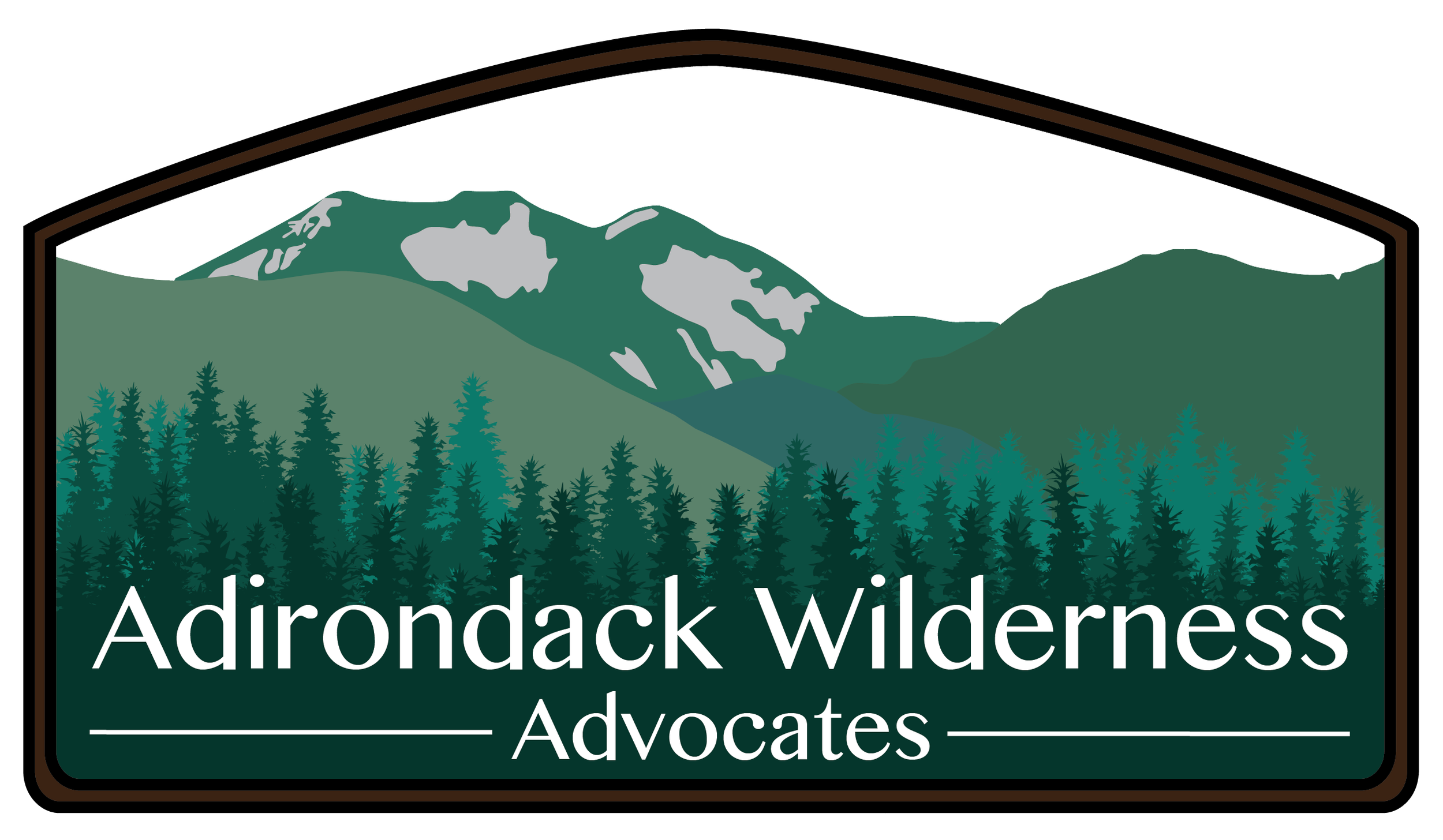
Pigeon Lake Wilderness
The name of the Pigeon Lake Wilderness belies the view that protected natural landscapes are completely shielded from human activities.
Pigeon Lake Wilderness
at a Glance
Size: 49,251 acres
First Designated: 1972
Unit Management Plan Status: Completed in 1992
Special Regulations: None; standard Forest Preserve regulations are in effect
Indeed, human actions that occur miles away can very much affect the wild places we seek to preserve.
The “pigeons” that inspired the name of this particular wilderness were passenger pigeons, a species that once numbered in the billions and traveled in prodigious flocks across the North American continent. But by 1914 the last known member died in the Cincinnati Zoo, leaving the landscape completely without one of its most visible avian components. Passenger pigeons were the victim of aggressive over-hunting, fueled in part by the quaint belief that species extinction was impossible in a natural world ordered by Providence; there would always be abundant numbers of birds because God would never permit their decline, therefore people hunted and trapped them with little discretion.
But the environmental experience of the nineteenth and early twentieth centuries—with the sharp decline of the bison herds, the sudden losses of chestnuts and elms, and the complete eradication of the passenger pigeons—proved these views to be false. Thus rose the early conservation movements, which challenged the Biblical notion of humanity’s complete dominion over nature. Instead, people began to see nature as a fragile resource capable of depletion and degradation, worthy of reverence rather than exploitation. This same expanding field of thought eventually led to the wilderness preservation movement, which viewed wild landscapes as something that were vulnerable to extinction, just like animals, birds, and trees.
Today there are no passenger pigeons at Pigeon Lake, the remote pond at the heart of its namesake wilderness area; only the name remains as an artifact of the days when enormous flocks once roosted here, probably defoliating much of the vegetation and coating the ground with guano. But now their presence is not even a memory, since no living person has ever seen a wild specimen of Ectopistes migratorius.
What does remain, though, is an enchanting fragment of their former range that is just shy of 50,000 acres in size. The Pigeon Lake Wilderness wraps around the modern second-home developments at Big Moose Lake and Twitchell Lake, with enough range to extend toward Eagle Bay, Stillwater Reservoir, and Raquette Lake. Its southern boundary is easily accessible at multiple locations, and a fine trail network serves as a guide to the area’s key features,
While the namesake passenger pigeons may be long vanished, what remains is hardly empty or desolate. This is an area of grand, old-growth forests, offering a glimpse of what some portions of pre-contact North America may have resembled, scattered with dozens of small ponds and lakes that feature enormous white pines along their shores. Moose still roam these forests, and the relative inaccessibility of the entire northern boundary means the area is perceived to be twice as wild and remote as its modest acreage would suggest.
Please click through the tabs below to learn more about the Pigeon Lake Wilderness.
-
Perhaps the chief feature of this wilderness is the forest itself, the majority of which was added to the fledgling Forest Preserve at an early date before any of it was logged. The preservation of the land went hand-in-hand with the subdivision of the shorelines at Big Moose and Twitchell, but nowhere else in the Adirondacks has so much old-growth timber been set aside in such unbroken acreage.
Its status as “old growth” does not mean that all of the trees are old and big, only that they have been enjoying uninterrupted lifecycles as long as anyone can remember. The age of the trees in an average patch of forest varies from the youngest saplings, reaching hopefully toward the canopy; to the oldest snags, which in death offer renewed habitat to birds, insects, small mammals, and fungi. The presence of all of these tree life stages in random distribution is the hallmark of a forest that has never been logged and exists more or less as natural forces dictate.
Which is not to say the Pigeon Lake Wilderness is completely undisturbed. Wind remains an agent of change, and in July 1995 this area experienced the ravages of a major storm. A few peripheral areas were not included in the original old-growth acquisitions, and some minor acreage was burned.
But the unlogged areas are easy to spot due to the preponderance of white pine, which was regarded as one of the most merchantable types of timber in the New World; wars were once waged over control of resources such as these. White pines now grow in uncounted numbers in the Pigeon Lake Wilderness, primarily along shorelines and waterways. One could probably find taller specimens in more accessible locations elsewhere, but the pines here tower over their neighbors—the lofty kings of an ancient forest.
The next most distinguished feature is the constellation of small interior lakes. The Pigeon Lake Wilderness does bare some affinity with the Five Ponds Wilderness to the north of the Beaver River, except that here the underlying terrain is somewhat more restless, resulting in far more rocky outcrops along the shorelines. Like most places in the western Adirondacks, these lakes did not completely escape the life-killing effects of acid rain, but a number of healthy trout ponds remain. And the inventive names of the ponds suggest that people have long enjoyed a positive relationship with this landscape, either by noting the features that impressed the early visitors most, or perhaps by memorializing noted historical figures. Each pond’s name suggests a story.
The region is rugged, but with few mountains worthy of the name. The wilderness is subdivided by a series of parallel ridges, few larger than the other, but prominent enough to arrange the watersheds into linear corridors. With a limited history of disturbance, there are few bald summits; even at West Mountain, the only mountain with a hiking trail, the encroaching forest growth limits what can be seen.
-
The history of the Pigeon Lake Wilderness is relatively simple: maps of the region confirm the area protected today has always been a wild area, devoid of roads and buildings, reserved for tramping and exploring for as long as there have been maps.
Human development in this area has been restricted to the desirable waterside locations at each of the large lakes that mark the area’s extremities. There, hotels staffed with guides catered to the early tourism industry, which increased first as railroad access to the region improved, and then automobiles and their ever-growing network of paved roads. But only a few of those fixtures ever penetrated the interior, thus resulting in the current ownership pattern: human occupation concentrated in a few narrow corridors, with room left over for a protected wilderness of ample proportions.
As a result, though, few sites within the wilderness boundaries have notable human histories. Trails do not follow old logging roads as they often do in other areas, nor are there abandoned cabin sites with rusting artifacts to offer insights into long-forgotten days. People hiked and paddled their way into the interior, camped at a handful of favorite sites, and then left without leaving behind any lasting structures.
Of the entire region, only three sites stand out as exceptions to its status as an unbroken tract of undeveloped forest:
Cascade Lake: This was the site of a girls’ summer camp in the twentieth century, which accounts for the spacious clearings that dot the northern shoreline, the cluster of stone foundations, and (most unlikely of all) the overgrown remains of a tennis court. Even the trail to and around the lake are based on the original driveway and equestrian trail. Forests in the vicinity of Cascade Lake show light evidence of past timber management, including the presence of a few non-native Norway spruce trees.
West Mountain: The highest summit in the wilderness was once the site of a fire tower, which was removed years ago to bring the area into compliance with the State Land Master Plan. A trail still leads over the summit, which was partially bared by long-ago forest fires, but views are limited due to the regrowth of the surrounding trees.
Anne LaBastille’s cabin site: The noted author and environmentalist owned a cabin on the east shore of Twitchell Lake, the setting for her famous Woodswoman book series. After her death, the cabin was relocated to the Adirondack Experience museum in Blue Mountain Lake, and the land was added to the Forest Preserve. This parcel was added to the Pigeon Lake Wilderness in 2018, although this was something of a token gesture for wilderness preservation and more of a nod to LaBastille’s service on the Adirondack Park Agency board; the additional wilderness acreage is welcome, and the LaBastille site is a significant cultural addition to the Forest Preserve, but it is severed from the main body of the wilderness by a powerline corridor and thus does little to increase the area’s protection.
-
With 42 miles of hiking trails and 5 lean-tos scattered throughout the area, the Pigeon Lake Wilderness is relatively easy to explore. But human use is not evenly distributed across all 50,000 acres, a trend that reflects the relative accessibility of each of the various trailheads. Despite its proximity to busy highways and lakes, there is more solitude to be found here than one might expect. However, if having the wilderness to yourself is your priority, then it is important to understand how the area’s unusual configuration affects the way visitors distribute themselves across the backcountry.
The most popular trailheads tend to be those with direct access from a paved road—namely, those along Big Moose Road and Higby Road. Here, three trailheads provide access to a looping trail network with focal points on Cascade and Queer Lakes, by far the two most popular destinations.
Cascade is a favorite family hike, which should not be surprising considering its history as a summer camp for girls. The trail is wide and easy to follow, not too long, with great views of the lake and its namesake waterfall. This is a trail that sees traffic throughout the year; in winter, it is a favored ski route.
Queer Lake is more rugged and a little more distant, but its lean-to is the Siren’s call that many people have heeded. The name has always been presumed to be a reference to the lake’s unusual shape, with matching peninsulas and sheltered bays. There are half a dozen ways to approach the lake, although they all converge on the same northwestern bay; the rest of Queer Lake, surprisingly, goes unseen. The “stump forest” surrounding the lean-to is an unfortunate testament to the inexperience many campers bring into the woods.
The remaining trails are more scattered and enjoy varying levels of use. Few people actually visit Pigeon Lake, the area’s namesake, and fewer still follow the connection to West Mountain. That being said, a “Tall Timber Traverse” that connects the Browns Tract Pond trailhead on Uncas Road with any of the termini on Big Moose Road is an outstanding way to sample one of the loneliest hiking trails in the Adirondacks.
The distant shores of Big Moose Lake conceal three more trailheads, each accessible only by boat. A town-maintained canoe launch at the end of Higby Road is the starting point for these adventures, where the remaining four lean-tos are found. Russian Lake is the easiest to access and perhaps the most popular; Lower Sister Lake boasts the remotest trail and the remotest lean-to. However, paddlers intending to reach these trails must contend with the potential for big waves and busy boat traffic on Big Moose Lake. Winter visitors must cross its frozen surface.
Traditionally, the area benefits from the ample snowfall that makes the western Adirondack region a haven for winter recreation, though only the Cascade Lake trail excels as a ski route; the ruggedness of the remaining trail system tends to favor snowshoes. Likewise, Cascade’s origins as an equestrian trail means it is still regarded as the area’s sole designated horse trail. It is primarily used as such by a commercial outfitter based in Eagle Bay.
The shortest trail in the area leads to Ferds Bog from Uncas Road, a favorite destination for bird watchers who come in search of gray jays, three-toed woodpeckers, and a variety of other birds.
The Browns Tract Ponds Campground abuts the southeastern boundary of the wilderness and is managed as a gateway facility. Otherwise, aside from the lean-tos, all backcountry camping is both primitive and widely dispersed.
One of the more frustrating aspects of the Pigeon Lake Wilderness is the fact that the entire northern boundary offers no public access whatsoever. This region is bounded by private reserves at Brandreth Lake and Thayer Lake, both of which are decidedly non-wilderness in nature. Thus places like Lower Sister Lake and Terror Lake seem more remote than they really are. That being said, the two private parks effectively create a corridor of lightly-developed land connecting with other state lands to the north, and so from the point of view of a moose Pigeon Lake is probably just one piece of an appealing mosaic of forest conditions.
-
The Pigeon Lake Wilderness is largely untroubled by controversy, with few user conflicts or management hot spots. One might wish that certain trails were kept in better condition, or that the people who have camped at the Queer Lake Lean-to over the years had cut fewer live trees for firewood. Otherwise, it is difficult to create a list of imminent threats like the ones that plague areas elsewhere in the Adirondack Park.
One of the closest things to a scandal involves the trail to Ferds Bog, the popular birding site along the southern boundary. As the name implies, this is a large wetland that wouldn’t be suitable for hiking in its native condition. Original plans for a nature trail called for a wooden structure in keeping with the wilderness aesthetic, but the actual trail DEC installed was made entirely out of plastic. Aesthetically this trail is… weird, but admittedly it seems to do its job well.
The ample snowfalls of the western Adirondacks make the region attractive to hikers, skiers, and snowmobilers alike. Oddly, conflicts with wilderness visitors and snowmobile riders are most likely to occur on the public roads that surround the wilderness, some of which double as snowmobile trails. On some days, snowmobiles outnumber cars and trucks.
Land acquisition would be desirable to expand the area and enhance access, but it is not likely to ever be much of a factor here. The small lot sizes and developed nature of the Big Moose area has made the land boundary stable for decades, with the addition of Anne LaBastille’s lot on Twitchell Lake being the most surprising expansion in recent years. On the other hand, a constitutional amendment in 2013 allowed certain landowners on Raquette Lake to resolve long-standing title disputes with the state. It remains unclear whether this process will add any additional acreage to the Forest Preserve over time.
Similarly, there is little likelihood the vast private reserves to the north of the wilderness will be acquired in the near future. When the Thayer Lake tract was on the market in the 2000s, it was deemed to be so encumbered by special use restrictions that there was no appetite to add it to the Forest Preserve. The Brandreth Lake tract has been in stable family ownership since the nineteenth century, with no indications that status is about to change soon.
-
The following links leave the AWA website and take you to various pages on the Department of Environmental Conservation (DEC) website with more information on the Pigeon Lake Wilderness.
Pigeon Lake Wilderness Information Page. Learn important contact information and peruse a list of facilities.
Backcountry Information for the Southwestern Adirondacks. Trail conditions updated weekly for the Pigeon Lake Wilderness and neighboring areas.
Pigeon Lake Wilderness Unit Management Plan (1992). Download DEC’s official management plan, approved in 1992.
State Land Regulations. Review the complete list of DEC regulations.
All photos © Bill Ingersoll. Site visitors are permitted to download an unlimited number of images from our website for personal, educational, scientific, or professional use only, with attribution. Commercial use and further distribution of images is prohibited without express written permission.
Maps of the Pigeon Lakes Wilderness and the Surrounding Area
Below is the current DEC map of the wilderness and its facilities. The remaining maps show the evolution of the area. Click maps to enlarge.




















